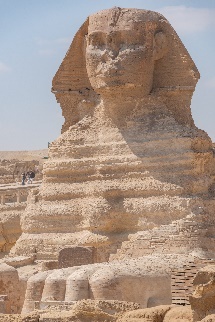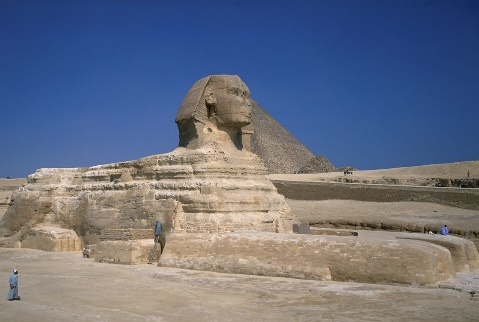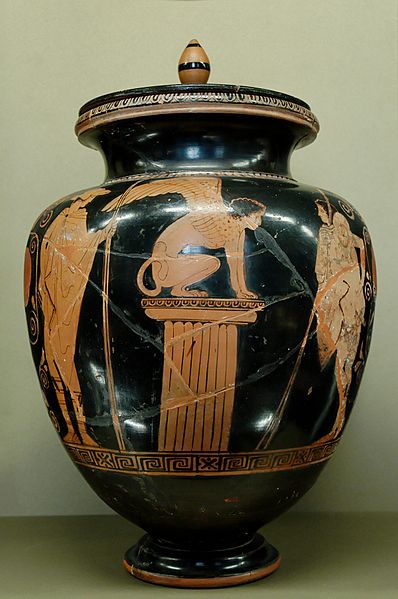Sphinx
Four mentions:
— Book 2 Canto 6
The wings that fold around created Space,
The sun-eyed Guardians and the golden Sphinx
And the tiered planes and the immutable Lords.
…
He had reached the top of all that can be known:
— Book 2 Canto 15
The grey-hued riddling nether shadow-Sphinx,
Her dreadful paws upon the swallowing sands,
Awaits him armed with the soul-slaying word:
— Book 3 Canto 4
— Book 6 Canto 2
Sri Aurobindo distinguishes in these four passages two categories of Sphinxes that appear in ancient mythologies.
The first category refers to the Egyptian Sphinx whom the Greeks called Androsphinx to distinguish it from the Sphinx whose upper part was that of a sheep or ram. It can be seen nearby the Giza pyramids. It is an unwinged lion in the reclining posture, the upper part of whose body is human. His face is said to depict Pharaoh Khafre, i.e. of a very advanced spiritual being.
Great Sphinx of Giza. Pexels. Public domain
The lion being the symbol of the ego or consciousness of separation, symbolized by the lion that Heracles must kill in his first Labour, the statue represents the absolute mastery of the lower nature that can only be achieved with the full realisation of the overmind. This realisation leads the adventurer of consciousness to the limits of the unknowable: He had reached the top of all that can be known. These limits are traditionally represented by large wings, like those, for example, at the top of the Caduceus of Hermes.
In this state of realisation, the adventurer can look up to the unrevealed heights of the supramental: A Sphinx whose eyes look up to a hidden Sun.
Considering its structuring consonants, the word Sphinx ΣΦΙΓΞ could indicate that identity with the divine (ΙΓΞ) is subject to the discernment of the human consciousness (ΣΦ). As we can assume that the pharaohs were spiritually very advanced beings, it is not only mental discernment but psychic discrimination that comes from union with the inner divine or inner presence.
Great Sphinx of Giza. Pexels. Public domain
The Mother refers to this achievement:
This immobile Consciousness is the “Mother of Dreams”, in the sphinx of eternity who keeps vigil on the confines of the world like an enigma to be solved. This enigma is the problem of our life, the very raison d’être of the universe. The problem of our life is to realise the Divine or rather to become once again aware of the Divine who is the Universe, the origin, cause and goal of life.
Those who find the secret of the sphinx of eternity become that active and creative Power.
To choose without preference and execute without desire is the great difficulty at the very root of the development of true consciousness and self-control. To choose in this sense means to see what is true and bring it into existence; and to choose thus, without the least personal bias for any thing, any person, action, circumstance, is exactly what is most difficult for an ordinary human being. Yet one must learn to act without any preference, free from all attractions and likings, taking one’s stand solely on the Truth which guides. And having chosen in accordance with the Truth the necessary action, one must carry it out without any desire.
If you observe yourself attentively, you will see that before acting you need an inner impetus, something which pushes you. In the ordinary man this impetus is generally desire. This desire ought to be replaced by a clear, precise, constant vision of the Truth.Sphinge
Quite different is the Greek Sphinx or rather Sphinge that appears in the Oedipus myth.
The daughter of Orthros and Echidna or the Chimera, (See It was the hour before the Gods awake and Hesiod, Theogony, 326) the Sphinge was sent to Thebes by Hera, the wife of Zeus, for some obscure reason. She had a woman’s face, the breast, feet, and tail of a lion, and bird wings. Posted at the entrance to Thebes, she devoured the young people of the city who failed to solve the riddle she posed to them. The riddle was: what is it that has one voice, and is four-footed and two-footed and three-footed? The oracle once prophesied that the Thebans would be free of the Sphinge when they guessed her riddle, so they often gathered trying to find the answer to it, but whenever they came up with the wrong answer, she would seize one of them and eat him up.
Oedipus solved the riddle, stating that the answer was ‘man’: as a baby he crawls on all fours, as an adult he is two-footed, and as he grows old he gains a third foot in the form of a cane. At this the Sphinge threw herself off the walls of the Acropolis.
Louvre Museum. Public domain
According to Hesiod, the Sphinge was born of Echidna, the symbol of cessation of the evolution in union (or from the Chimera – the symbol of unconsciousness and darkness, and thus of illusion) and Orthros, the symbol of falsehood or insincerity. It is, therefore, symbolically the result of the serious deviance and its consequences that occurs at the moment when humanity has developed the consciousness of separation. Hera, the spouse of Zeus, is the symbol of the limiting force, the force that ensures that the seeker cannot advance further when he is not ready. This is the reason why the young men of Thebes are killed. They represent the beginning of advanced purification practices, Thebes being the symbolic representation of the purification of the centres of consciousness or chakras that precedes the great reversal represented by the Trojan War.
The story takes place at the moment when Oedipus arrives at the gates of Thebes, that is, when the seeker approaches a thorough purification of the consciousness-energy centres or chakras, represented by the seven gates of Thebes.
Hesiod does not use the word Sphinx (ΣΦΙΓΞ) but prefers Phix (ΦΙΞ), thereby indicating the lack of discernment (Σ) in the process of identification with the divine (Ξ).
The Greek Sphinx (Sphinge) has wings, which suggests a mental state. And her head is that of a woman, indicating not mastery but passivity in the face of the ego, which is then free to manifest itself fully. This is why she is ‘The grey-hued riddling nether shadow-Sphinx’.
The Greek Sphinx devouring the young adults of Thebes is thus the symbol of the seeker who is blocked in his spiritual development because of his unconsciousness and insincerity, which can result in a mental spiritual pride.
It seems that Sri Aurobindo expects that every seeker must confront this Sphinge at some time or other: He too must grapple with the riddling Sphinx And plunge into her long obscurity.
At this point, it is no longer a struggle, but the need for perfect sincerity combined with a certain candour that causes the obstacle to dissolve: the Sphinge throws herself from the ramparts and dies when Oedipus finds the right answer to the riddle.
Here, as with all the monsters guarding ’thresholds’, the Sphinge has a double aspect: destructive, but also protective in the sense that it protects the seeker when he is not ready to face certain profound purifications. There are indeed always entities or forces ready to pull the seeker off the path first by flattering his ego and then by more subtle means.


